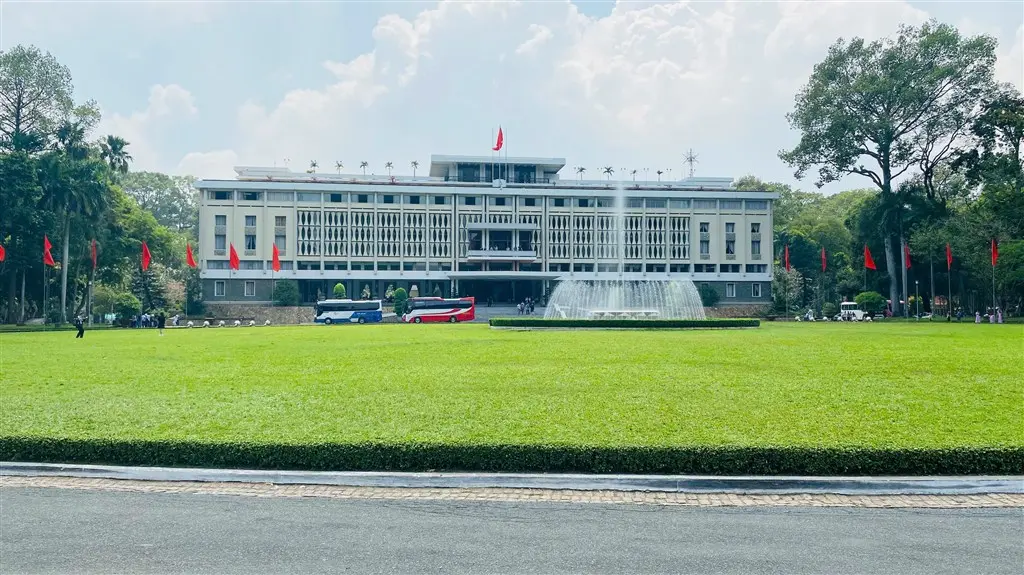Welcome to the delightful world of Vietnamese sweets. While many know Vietnam for savory dishes like pho or banh mi, essentialvietnamtravel.com invites you to explore the equally fascinating universe of its desserts.. Yet, an equally exciting universe exists in its desserts. These treats offer unique tastes and textures. They reflect the country’s rich food culture and use of fresh, tropical ingredients.
EssentialVietNamtravel invites you to explore this often-overlooked part of Vietnamese cuisine. Prepare to discover sweet soups, chewy cakes, refreshing jellies, and more. This guide will introduce you to popular desserts from Vietnam, their key ingredients, cultural roles, and where you can find them. Forget heavy, overly rich sweets. Vietnamese desserts often present a lighter, more balanced experience. Let’s dive in.
Unveiling Vietnamese Desserts: Beyond Pho and Banh Mi
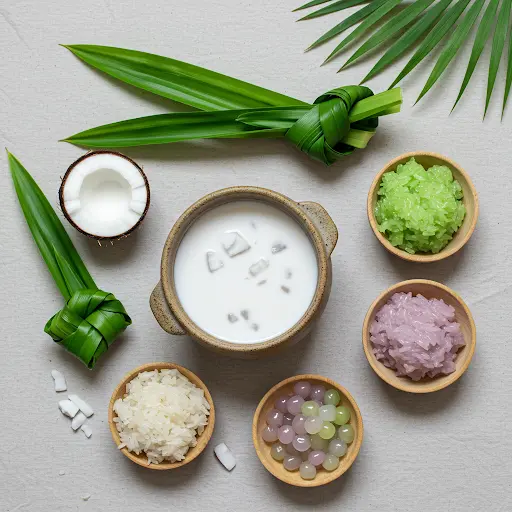
Vietnamese desserts represent a fascinating and distinct branch within the broader landscape of Vietnamese cuisine. These sweet creations are often categorized under two encompassing terms: Che and Banh. Che typically refers to a wide array of sweet liquids – ranging from thin dessert soups and refreshing beverages to thicker puddings or gruels.
Banh, on the other hand, is an incredibly versatile term covering countless items, primarily cakes, pastries, pies, and even certain types of dumplings, whether sweet or savory (though here we focus on the sweet varieties). This classification highlights the sheer diversity right from the start.
What truly sets Vietnamese sweets apart, especially when contrasted with many traditional Western desserts, is their underlying philosophy. Instead of relying heavily on butter, refined wheat flour, and large amounts of processed sugar for richness and structure, desserts from Vietnam often pursue a different path.
They champion balance. Flavors are layered subtly, textures are deliberately contrasted, and sweetness often comes from natural sources rather than being overwhelming. Freshness is paramount, drawing heavily on the bounty of Asian desserts ingredients.
At the heart of many recipes lies Coconut milk. Used in various forms – from thin milk as a cooking liquid to rich cream as a topping – it imparts a characteristic tropical richness without the heaviness often associated with dairy. It’s a cornerstone flavor. Equally important is the fragrant Pandan leaf. Used either whole (tied in a knot and simmered) or juiced for its vibrant green color, it lends a unique, almost grassy-vanilla aroma and flavor that is instantly recognizable.
Furthermore, Sticky rice (glutinous rice) and various types of rice flour (glutinous for chewiness, regular rice flour for structure, tapioca starch for a specific bouncy texture) are fundamental building blocks. They create the deeply satisfying chewy, soft, and sometimes jelly-like textures that are a hallmark of this category.
The variety within Vietnamese desserts is immense, catering to different preferences and climates. You’ll discover warm, comforting bowls of sweet soup, thick with beans or sticky rice, perfect for cooler weather or a soothing end to a meal. Conversely, you find incredibly refreshing chilled Che, jellies (Rau Cau Dua – coconut jelly, Suong Sa Hat Luu – jelly with pomegranate-like seeds), and fruit cocktails ideal for combating the tropical heat.
Texture, perhaps more so than in many other dessert cultures, plays a crucial and deliberate role. It’s not merely an afterthought; it’s often the star. Prepare your palate for a dynamic interplay: imagine the yielding smoothness of a coconut custard (Banh Flan) meeting the distinct pop-and-chew of tapioca pearls; picture biting through the incredibly thin, shatteringly crispy shell of a fried pastry (Banh Cam) to reach a soft, dense filling; visualize a light, airy, spongy steamed cake (Banh Bo) designed to soak up luscious, sweet syrups or coconut cream.
This intense focus on mouthfeel transforms the act of eating Vietnamese desserts into a truly engaging, multi-sensory experience. It is rarely just about the sweetness level; it’s fundamentally about the captivating dance between elements that are simultaneously soft, chewy, crispy, crunchy, gelatinous, and smooth within a single dish or even a single bite.
Adding another layer of uniqueness, many traditional vietnamese desserts ingeniously incorporate ingredients often reserved for savory dishes elsewhere. Beans and legumes – like mung beans (mashed into pastes, left whole) and red beans – are commonplace, lending earthy sweetness, body, and creamy texture. Even vegetables find their place in the sweet repertoire: Chè Bắp features sweet corn kernels simmered in coconut milk, while taro adds a unique starchy richness to certain puddings.
These unexpected sweet preparations might surprise newcomers but showcase the resourcefulness and creativity inherent in the cuisine. This guide from EssentialVietNamtravel.com aims to pull back the curtain on these wonderful sweet foods, demystifying their components and highlighting the sheer ingenuity found within Vietnam desserts. Grasping the fundamental concepts of Che and Banh, and appreciating the emphasis on ingredients and texture, is the essential first step to fully appreciating this delicious and vital aspect of the country’s vibrant food culture.
Exploring Popular Vietnamese Sweets: From Che to Banh
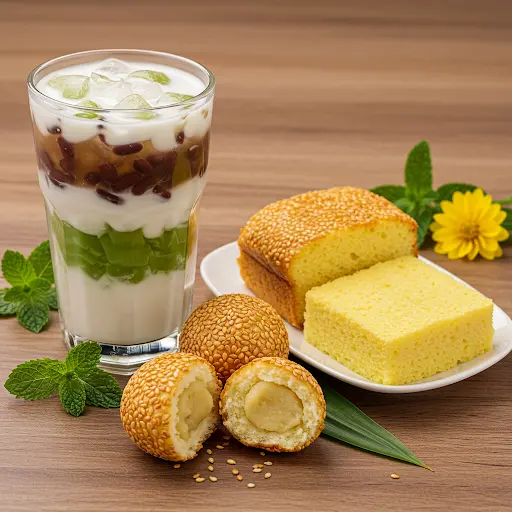
Venturing into the world of Vietnamese desserts reveals an incredible variety. While countless regional specialties exist, several key players appear frequently in homes, restaurants, and bustling street food stalls across Vietnam Getting to know these popular options provides a great starting point for your exploration. They showcase the typical ingredients, textures, and flavors you can expect.
Many fall under the broad categories of che (sweet soups/puddings) or bánh (cakes/pastries). Let’s look at some specific, much-loved examples. These vietnamese treats represent different preparation styles and flavor profiles, offering something for nearly every palate. From colorful layered concoctions to simple, comforting bowls, the diversity is part of the appeal. We will explore three iconic examples here: Chè Ba Màu, Bánh Cam, and Bánh Bò. Each offers a unique window into the delightful realm of vietnam sweets
Chè Ba Màu (Three Color Dessert): A Visual and Textural Delight
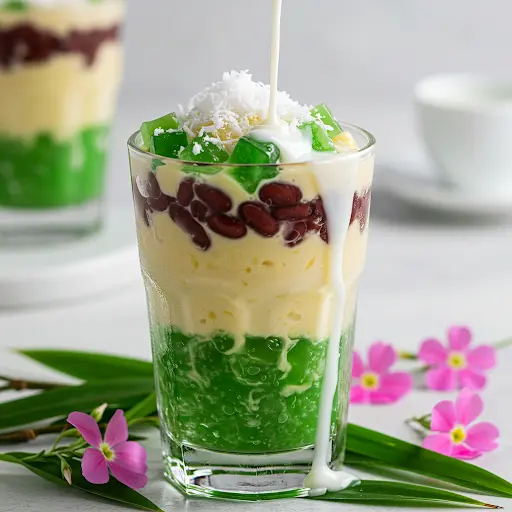
chè ba màu is easily one of the most visually appealing vietnamese desserts . Its name translates to “three-color dessert,” and it lives up to it. Served typically in a tall glass to showcase its distinct layers, this che is a feast for the eyes before it even reaches your lips. The beauty lies in the combination of textures and subtle flavors. The main Ingredients usually consist of vibrant green pandan jelly (bánh lọt), creamy yellow mung bean paste , and deep red kidney beans (rea beans) or azuki beans.
These layers are then generously topped with crushed ice and drizzled with rich, sweet coconut milk . Sometimes, other elements like water chestnut pearls (hạt lựu) are added for extra crunch. To enjoy it, you typically stir the layers together, creating a harmonious blend of chewy jelly, smooth bean paste, soft beans, and creamy coconut milk. It’s refreshing, subtly sweet, and texturally complex – a perfect example of a popular vietnamese sweet soup. Finding this dessert vietnamese food is is common in Vietnamese restaurants and cafes worldwide.
Bánh Cam / Bánh Ran (Sesame Balls): Crispy, Chewy Perfection
Bánh cam (Southern Vietnamese name) or Bánh Ran (Northern name) are deep-fried sesame balls that offer pure textural satisfaction. Imagine biting through a layer of crispy, golden-brown dough studded generously with Toasted sesame seeds This gives way to a wonderfully chewy inner layer made from glutinous rice flour. Inside waits a sweet surprise: typically a smooth, golden mung bean paste filling, though variations exist. The combination of the outer crunch, the chewy mochi-like dough, and the sweet, soft filling is addictive. The Texture is the star here: chewy crispy perfection .
These balls are often enjoyed as a snack or a simple vietnam pastry . While sweet, the sweetness is usually balanced, coming mainly from the filling. They are best eaten fresh and warm when the contrast between the crispy exterior and chewy interior is most pronounced. Look for these golden orbs at street food stalls in Hanoi or Ho Chi Minh city , or in Vietnamese bakeries abroad. They represent a simpler, yet deeply satisfying type of Vietnamese desert .
Bánh Bò (Honeycomb Cake): A Spongy, Coconutty Treat
Bánh bò is a fascinating steamed cake known for its unique, porous structure that resembles a honeycomb. This airy texture comes from the fermentation process involving rice flour, tapioca starch, sugar, water or coconut milk , and yeast or a traditional starter. The flavor profile is typically sweet coconutty , often enhanced further with the fragrant essence of pandan leaf , which sometimes also lends it a beautiful green color (Bánh Bò Lá Dứa).
There’s also a baked version, Bánh Bò Nướng, which develops a caramelized crust. The steamed version, however, is prized for its soft, slightly chewy, and incredibly spongy texture that readily absorbs surrounding flavors if served with extra coconut sauce. Making Banh bo Nuong or the steamed version requires patience for the batter to ferment correctly, developing the characteristic honeycomb channels during cooking.
This banh is a wonderful example of how simple ingredients like rice flour and coconut milk transform into something texturally unique through specific preparation methods . It’s a beloved dessert vietnamese families often enjoy.
Key Ingredients Shaping Flavor and Texture in Vietnamese Desserts

The unique character of vietnamese desserts stems directly from the local bounty and culinary preferences of southeast Asia . Understanding the core ingredients helps appreciate the resulting flavors and textures. Coconuts milk is arguably the most ubiquitous ingredient, providing richness, a subtly sweet tropical flavor, and a creamy base for countless che varieties and sauces for banh.
Unlike dairy cream, it offers a lighter richness. Sweeteners vary; while white sugar is used, palm sugar offers a deeper, more caramelly note, and condensed milk is a very common sweetener, particularly in drinks and some dessert preparations like Banh Flan or drizzled over ice.
Fruits play a starring role. Banana is key in the warm, comforting chè chuối . Durian, the famously pungent fruit, lends its unique creamy texture and intense flavor to the filling of Bánh pia (a flaky pastry often associated with Soc Trang province). Mangoes, jackfruit, lychees, and longans frequently appear in refreshing sweet soups and jellies. Beans and legumes are surprisingly common.Mung bean paste, either sweetened or plain, fills pastries like Bánh cam and Bánh pia and features in chè Ba màu.
Red beans add substance and color. Even vegetables find their way into sweets: chè bắp features sweet Corn, while taro adds a starchy creaminess to others. Jellies add another textural dimension. Grass jelly , the Base Ingredient for sương sáo, offers a cooling, slightly herbal note. Agar-agar creates firmer jellies, often coconut or fruit-flavored (Rau cau dua).
The Appearance of Bánh Da Lợn (literally “pig skin cake”) comes from alternating steamed layers of tapioca/rice flour batter, often colored green with pandan and yellow with mung bean. Ingredient leads to Flavor is a clear principle here, as is how Preparation determines Texture.
The smooth, custardy Texture of Bánh Flan comes from eggs and milk (often condensed), while the Main Ingredient of Tàu Hũ Nước Đường is incredibly Soft Tofu served in ginger syrup. The Chewy sticky Texture of Bánh Xu Xê (husband and wife cake) comes from tapioca starch.
Common Preparation Methods: Steaming, Boiling, and Chilling
How Vietnamese desserts are prepared is just as important as the ingredients used, directly influencing the final Texture and taste. Preparation Methods Example: Steaming is incredibly common, especially for various types of Banh. Cakes like Bánh Bò and the layered Bánh Da Lợn rely on steam heat to cook through, creating soft, moist, and often chewy results. This gentle cooking method preserves delicate flavors and textures.
Step-by-step insight: For steamed cakes, a batter is typically prepared using ingredients like rice flour, tapioca starch, sugar, and Coconut milk. This batter is poured into molds or pans placed inside a steamer. Covering the steamer lid with a cloth can prevent condensation from dripping onto the cake surface. Steaming time varies depending on the cake’s size and density. Ensuring the water in the steamer doesn’t run out is crucial.
Boiling or simmering is the primary method for making Che (sweet soups). Ingredients like beans, sticky rice, Tapioca pearls, fruits (Banana for Chè Chuối), or vegetables (Corn for Chè Bắp) are gently cooked in water or Coconut milk with sugar until tender and the flavors meld. This method is straightforward but requires attention to prevent burning and achieve the right consistency.
Chilling and setting are used for jellies and custards. Agar-agar or Grass jelly mixtures are heated to dissolve, then poured into molds and refrigerated until firm. Bánh Flan is often steamed in a water bath (bain-marie) until the custard sets, then chilled before serving, highlighting its smooth custardy Texture. Kem Dừa (Vietnamese coconut ice cream) obviously relies on freezing, achieving its characteristic Cold Serving Temperature.
Cultural Context: Vietnamese Desserts in Daily Life and Celebrations
Vietnamese desserts are more than just a sweet ending to a Meal course; they are woven into the fabric of daily life and special occasions in Vietnam. Their Cultural significance varies, connecting people to traditions, seasons, and important life events. On any given day, especially in cities like Hanoi or Ho Chi Minh City, you’ll find numerous Street food vendors selling refreshing Che or various Banh as afternoon snacks or simple pick-me-ups.
Dreaming of a Food Tour in Vietnam?
Discover the vibrant street food scenes of Hanoi & Ho Chi Minh City. Find the best flight deals to start your culinary adventure!
Find Flights with WayAway (Cashback Available!)
Explore Flight Options on Kiwi.com
(Booking through these affiliate links supports our site at no extra cost to you.)
These readily available Vietnamese treats offer affordable moments of pleasure. They provide energy and often a cooling respite from the tropical heat, explaining the popularity of chilled options like Sương Sáo (grass jelly) or various fruit cocktails.
Specific desserts are strongly associated with particular events. Chè Trôi Nước (floating rice dumplings in ginger syrup) is a classic Occasion dessert, traditionally eaten during Tet Nguyen Dan (Vietnamese Lunar New Year). The round dumplings symbolize family reunion and completeness. Bánh Xu Xê (husband and wife cake), with its sticky, chewy texture symbolizing a close-knit bond, is often present at weddings.
Regional variations (Region causes Variation) are pronounced. For instance, Hue, the former imperial capital (Regional Origin Example), is renowned for its delicate and intricate royal desserts, often smaller and more refined than those found elsewhere. Influence from neighboring cultures is also visible; Chè Thái clearly shows Thai Cuisine Influence, typically incorporating various tropical fruits and jellies often seen in Thai desserts.
Some ingredients, like those in certain herbal jellies, are believed to have Medicinal properties, such as cooling effects. The choice of dessert might also reflect Seasonal variations, with certain fruits featured only when they are in season. Occasion influences Dessert type is a key takeaway. These sweets are integral to Vietnamese food culture.
Finding and Savoring the Best Vietnamese Desserts
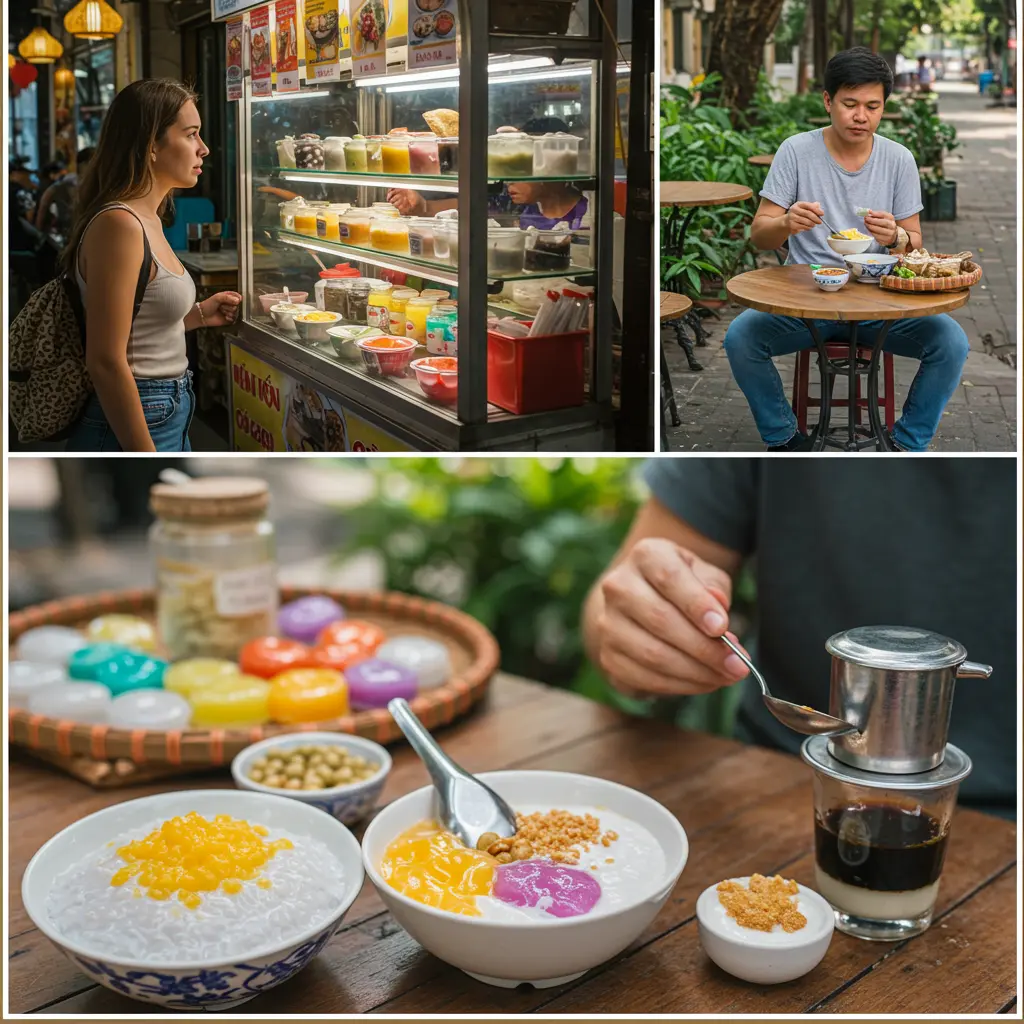
Now that you’re acquainted with the variety and appeal of Vietnamese desserts, the next step is experiencing them. Finding authentic desserts from Vietnam is easier than you might think, both within Vietnam and internationally. In cities like Hanoi and Ho Chi Minh City, Street food stalls are treasure troves. Look for vendors specializing in specific types of Che or Banh.
Don’t hesitate to try things that look interesting – often, the most unassuming stalls offer the most delicious treats. This addresses the find local shops and where to buy Vietnamese desserts near me search intent, especially for travelers. Vietnamese restaurants worldwide usually feature a dessert section on their menu, offering classics like Chè Ba Màu, Bánh Flan, or fruit-based Che.
Specialized Vietnamese bakeries or cafes are excellent places to find a wider range of Banh, including Bánh Bò, Bánh Da Lợn, and savory/sweet pastries like Bánh Pia. Asian supermarkets often carry pre-packaged Vietnamese sweets or ingredients if you’re interested in easy Vietnamese dessert recipes or a specific traditional Vietnamese che recipe.
When choosing, look for freshness. Che is best enjoyed shortly after it’s made. For pastries, ask when they were baked. Don’t be afraid to ask for recommendations. For the ultimate experience, consider pairing your dessert. A strong, aromatic Vietnamese coffee provides a wonderful contrast (Drink Pairing) to the sweetness of many desserts. While exploring Vietnamese savory dishes is essential, saving room for the sweet finale completes the culinary picture.
Remember that Temperature affects Serving style – some Che are best warm, others chilled. EssentialVietNamtravel.com encourages you to explore types and be adventurous. Ask locals for their favorites. Comparing options (compare options) at different vendors can lead you to discover the truly best Vietnamese desserts. Embrace the unique textures and flavors.
Vietnamese desserts offer a captivating journey of flavor, texture, and cultural richness. Moving beyond the well-known savory dishes reveals a world of Che, Banh, and countless other Vietnamese sweets that utilize local ingredients like Coconut milk, pandan, rice, and tropical fruits in creative ways. From the layered beauty of Chè Ba Màu to the crispy chewiness of Bánh Cam and the spongy delight of Bánh Bò, there’s a vast landscape to explore.
Further Reading: Explore More of Vietnam’s Culinary Delights
Understanding the common ingredients, preparation methods, and cultural context enhances appreciation for these traditional Vietnamese desserts. Whether found at a bustling street stall in Southeast Asia, a local Vietnamese restaurant, or made using an easy Vietnamese dessert recipe at home, these treats provide a unique and satisfying end to any meal or a delightful snack on their own. EssentialVietNamtravel hopes this guide inspires you to seek out and savor the amazing variety of desserts from Vietnam. Don’t miss out on this essential part of Vietnamese cuisine.

